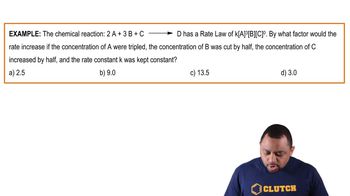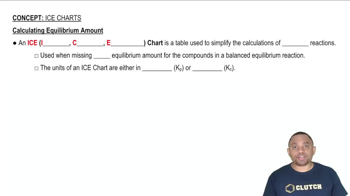At 25°C, the reaction CaCrO4(𝑠) ⇌ Ca2+(𝑎𝑞) + CrO42−(𝑎𝑞) has an equilibrium constant 𝐾𝑐 = 7.1×10−4. What are the equilibrium concentrations of Ca2+ and CrO42− in a saturated solution of CaCrO4?
Ch.15 - Chemical Equilibrium
Chapter 15, Problem 56
For the reaction I2(g) + Br2(g) ⇌ 2 IBr(g), Kc = 280 at 150 _x001F_C. Suppose that 0.500 mol IBr in a 2.00-L flask is allowed to reach equilibrium at 150 _x001F_C. What are the equilibrium concentrations of IBr, I2, and Br2?
 Verified step by step guidance
Verified step by step guidance1
Step 1: Write the balanced chemical equation for the reaction: I2(g) + Br2(g) ⇌ 2 IBr(g).
Step 2: Define the initial concentrations of the reactants and products. Since 0.500 mol of IBr is placed in a 2.00 L flask, the initial concentration of IBr is 0.500 mol / 2.00 L = 0.250 M. The initial concentrations of I2 and Br2 are both 0 M.
Step 3: Set up an ICE (Initial, Change, Equilibrium) table to track the changes in concentrations. Let x be the change in concentration of I2 and Br2 that reacts to form IBr. The changes in concentration will be: I2: +x, Br2: +x, IBr: -2x.
Step 4: Express the equilibrium concentrations in terms of x: [I2] = x, [Br2] = x, [IBr] = 0.250 - 2x.
Step 5: Use the equilibrium constant expression Kc = [IBr]^2 / ([I2][Br2]) = 280 to solve for x. Substitute the equilibrium concentrations into the expression and solve for x to find the equilibrium concentrations of I2, Br2, and IBr.
Key Concepts
Here are the essential concepts you must grasp in order to answer the question correctly.
Equilibrium Constant (Kc)
The equilibrium constant (Kc) is a numerical value that expresses the ratio of the concentrations of products to reactants at equilibrium for a given reaction at a specific temperature. For the reaction I2(g) + Br2(g) ⇌ 2 IBr(g), Kc = [IBr]^2 / ([I2][Br2]). A higher Kc value indicates a greater concentration of products at equilibrium.
Recommended video:
Guided course

Equilibrium Constant Expressions
Initial Concentration and Changes at Equilibrium
To find the equilibrium concentrations, we start with the initial concentration of IBr and assume that the changes in concentrations of I2 and Br2 are represented by 'x'. The initial concentration of IBr is calculated from the number of moles and volume of the flask, and the changes in concentrations are determined based on the stoichiometry of the reaction.
Recommended video:
Guided course

Concentration Changes and Rate Law Example
ICE Table (Initial, Change, Equilibrium)
An ICE table is a tool used to organize the initial concentrations, the changes in concentrations, and the equilibrium concentrations of reactants and products in a chemical reaction. By filling out the ICE table with the initial amounts, the changes (based on the stoichiometry), and solving for equilibrium concentrations, one can systematically determine the concentrations at equilibrium.
Recommended video:
Guided course

ICE Charts and Equilibrium Amount
Related Practice
Textbook Question
Textbook Question
At 2000°C, the equilibrium constant for the reaction 2 NO(𝑔) ⇌ N2(𝑔) + O2(𝑔) is 𝐾𝑐 = 2.4×103. If the initial concentration of NO is 0.175 M, what are the equilibrium concentrations of NO, N2, and O2?
1
views
Textbook Question
For the equilibrium Br2(𝑔) + Cl2(𝑔) ⇌ 2 BrCl(𝑔) at 400 K, 𝐾𝑐 = 7.0. If 0.25 mol of Br2 and 0.55 mol of Cl2 are introduced into a 3.0-L container at 400 K, what will be the equilibrium concentrations of Br2, Cl2, and BrCl?
1
views
Textbook Question
At 373 K, 𝐾𝑝 = 0.416 for the equilibrium 2 NOBr(𝑔) ⇌ 2 NO(𝑔) + Br2(𝑔) If the equilibrium partial pressures of NOBr(𝑔) and Br2(𝑔) are both 0.100 atm at 373 K, what is the equilibrium partial pressure of NO(𝑔)?
